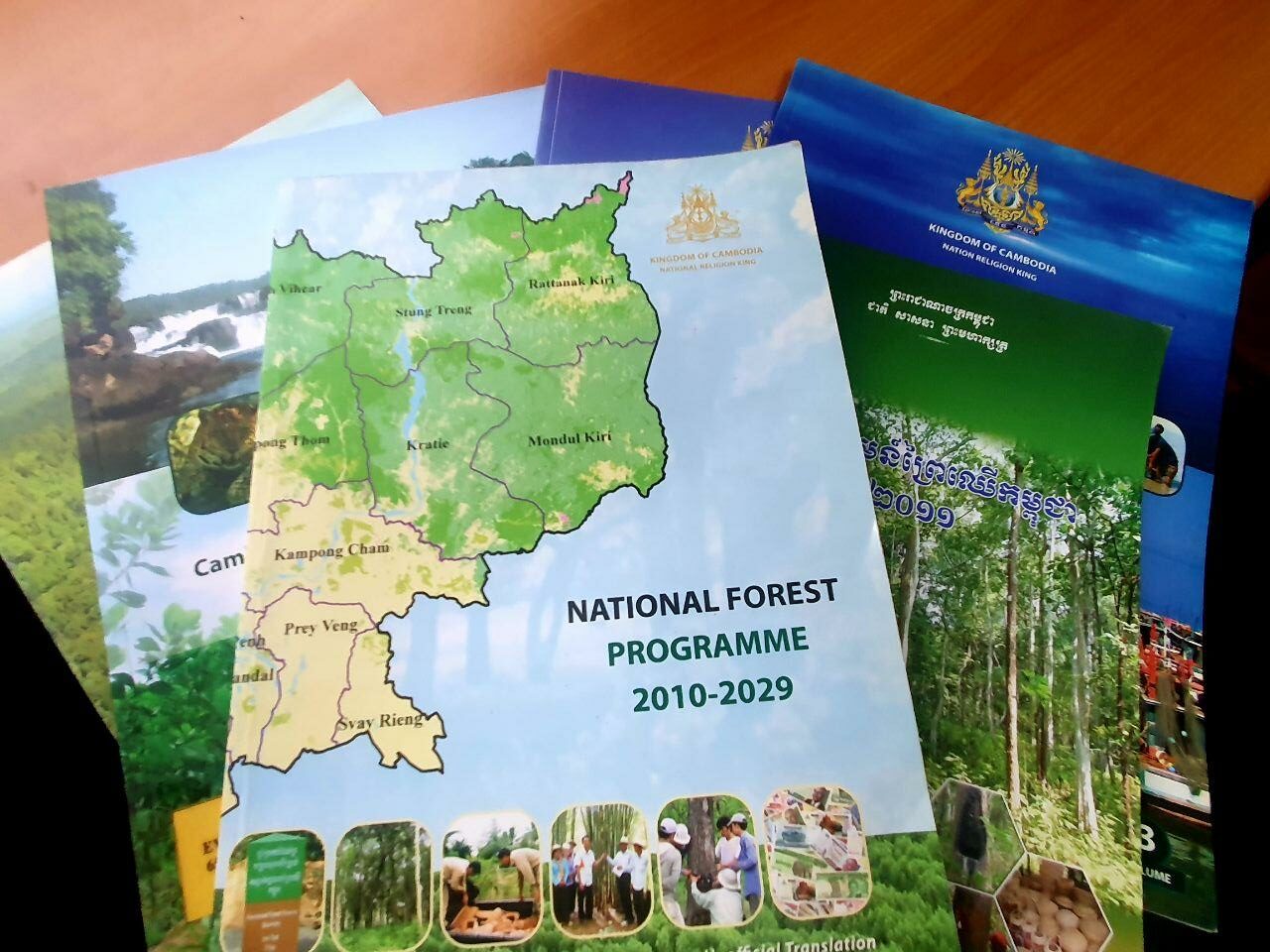ច្បាប់ស្តីពីបរិស្ថាន គឺជាវិស័យច្បាប់ដែលទើបតែលេចចេញជារូបរាងដែលមិនទាន់មានអ្នកជំនាញខាងការអប់រំ និងការអនុវត្តច្បាប់បរិស្ថាននៅឡើយទេ។ ចាប់ពីឆ្នាំ ២០១៤ រហូតមកដល់បច្ចុប្បន្ននេះ ក្រសួងបរិស្ថាននៃប្រទេសកម្ពុជាបាននាំមុខក្នុងការរៀបចំក្រមបរិស្ថាន និងធនធានធម្មជាតិដែលមិនធ្លាប់មានពីមុនមកក្នុងគោលបំណងបង្កើតក្របខ័ណ្ឌច្បាប់បរិស្ថានទូទៅសម្រាប់ប្រទេស។ សេចក្តីព្រាងក្រមនេះមិនទាន់ត្រូវបានអនុម័តដោយសភានៅឡើយទេ។

កម្រងឯកសារនានាពាក់ព័ន្ធនឹងការគ្រប់គ្រងធនធានព្រៃឈើនៅកម្ពុជារបស់រាជរដ្ឋាភិបាល។ រូបភាពដោយអង្គការទិន្នន័យអំពីការអភិវឌ្ឍ ថតនៅថ្ងៃទី ២៩ ខែកញ្ញា ឆ្នាំ ២០២០។ ក្រោមអាជ្ញាបណ្ណ CC BY-SA 4.0.
ចាប់តាំងពីឆ្នាំ ២០១៨ យុទ្ធសាស្ត្រណែនាំរបស់រាជរដ្ឋាភិបាលកម្ពុជាគឺ យុទ្ធសាស្ត្រចតុកោណដំណាក់កាលទី ៤ ។1 ក្រោមយុទ្ធសាស្ត្រនេះការការពារ និងអភិរក្សបរិស្ថានត្រូវបានផ្តល់អាទិភាពខ្ពស់។ យុទ្ធសាស្ត្រនេះមានគោលបំណងបង្កើនប្រសិទ្ធភាពនៃការការពារ និងអភិរក្សបរិស្ថានធនធានធម្មជាតិ ប្រព័ន្ធអេកូឡូស៊ី ជីវចម្រុះ ព្រៃឈើ និងជម្រកសត្វព្រៃក៏ដូចជាការបន្សាំទៅនឹងការប្រែប្រួលអាកាសធាតុ។
ការគ្រប់គ្រងបរិស្ថាន និងធនធានធម្មជាតិត្រូវបានពង្រឹងឡើងតាមរយៈការអនុវត្ត ឬ ពង្រឹង៖
- ការគ្រប់គ្រងធនធានរ៉ែ
- កំណែទម្រង់វិស័យព្រៃឈើ និងជលផលរួមទាំងការអភិរក្សជលផល
- កំណែទម្រង់ដីធ្លី
- ការគ្រប់គ្រងធនធានទឹករួមមានប្រព័ន្ធអេកូនៃបឹងទន្លេសាប និងទន្លេមេគង្គ។
វានៅតែមានបញ្ហាប្រឈមដែលទាមទារការខិតខំប្រឹងប្រែង និងការផ្តួចផ្តើមគំនិតបន្ថែមទៀតដើម្បីធានាការអភិវឌ្ឍប្រកបដោយចីរភាព។ បំរែបំរួលអាកាសធាតុក៏បាននឹងកំពុងបង្កផលប៉ះពាល់អវិជ្ជមានដល់ប្រព័ន្ធអេកូឡូស៊ីក៏ដូចជាជះឥទ្ធិពលដល់ការអភិវឌ្ឍសេដ្ឋកិច្ចសង្គមរបស់កម្ពុជាផងដែរ។
ព្រះរាជក្រឹត្យស្ដីពីការការពារតំបន់ធម្មជាតិ (១៩៩៣)
តាមព្រះរាជក្រឹត្យនេះ លេខាធិការដ្ឋានបរិស្ថានទទួលបន្ទុកគ្រប់គ្រង និងត្រួតពិនិត្យការអភិវឌ្ឍន៍ និងការពារតំបន់ធម្មជាតិរួមមានការការពារបរិស្ថាន ដីធ្លី ព្រៃឈើ តំបន់ដីសើម និងតំបន់ឆ្នេរ។ លេខាធិការដ្ឋានបរិស្ថានមានសិទ្ធិបង្កើត និងដឹកនាំគណៈកម្មាធិការសមស្របដើម្បីសម្របសម្រួលសកម្មភាពអន្តរក្រសួងទាំងនៅកម្រិតនយោបាយនិងបច្ចេកទេស។ ការគ្រប់គ្រងនិងការត្រួតពិនិត្យតំបន់អភិរក្សធម្មជាតិ គឺជាទំនួលខុសត្រូវរបស់លេខាធិការដ្ឋានបរិស្ថានក្នុងការសហការជាមួយស្ថាប័នពាក់ព័ន្ធដទៃទៀត។
ច្បាប់ស្តីពីការការពារបរិស្ថាននិងការគ្រប់គ្រងធនធានធម្មជាតិ (១៩៩៦)
គោលបំណងនៃច្បាប់នេះគឺដើម្បី៖
- ការពារ និងលើកកម្ពស់គុណភាពបរិស្ថាន
- វាយតម្លៃផលប៉ះពាល់បរិស្ថាននៃគម្រោងដែលបានស្នើមុនពេលរដ្ឋាភិបាលធ្វើការសម្រេចចិត្តជាផ្លូវការលើពួកគេ
- ជំរុញការប្រើប្រាស់ធនធានធម្មជាតិប្រកបដោយនិរន្តរភាពនៅកម្ពុជា
- ជំរុញនិងអនុញ្ញាតឱ្យសាធារណជនចូលរួមក្នុងការការពារបរិស្ថាននិងការគ្រប់គ្រងធនធានធម្មជាតិ
- បង្ក្រាបរាល់សកម្មភាពទាំងឡាយណាដែលបង្កអន្តរាយដល់បរិស្ថាន
អនុក្រឹត្យស្តីពីដំណើរការវាយតម្លៃផលប៉ះពាល់បរិស្ថាន (១៩៩៩)
អនុក្រឹត្យនេះតំរូវអោយមានការវាយតម្លៃផលប៉ះពាល់បរិស្ថាន (EIA) លើរាល់គំរោង និងសកម្មភាពឯកជន និងសាធារណៈ។ ការវាយតម្លៃត្រូវតែពិនិត្យដោយក្រសួងបរិស្ថានមុននឹងដាក់ជូនរាជរដ្ឋាភិបាលដើម្បីធ្វើការសំរេចចិត្ត។អនុក្រឹត្យនេះអនុវត្តចំពោះគម្រោងដែលបានស្នើសុំគ្រប់ប្រភេទដែលមានចុះក្នុងឧបសម្ព័ន្ធនៃអនុក្រឹត្យលើកលែងតែគម្រោងនានាដែលគិតថាចាំបាច់នៅក្នុងស្ថានភាពប្រកាសអាសន្ន និងត្រូវបានអនុម័តដោយរាជរដ្ឋាភិបាល។
អនុក្រឹត្យស្តីពីការគ្រប់គ្រងការបំពុលទឹក (១៩៩៩)
ច្បាប់នេះមានគោលបំណងគ្រប់គ្រងការត្រួតពិនិត្យទឹកដើម្បីការពារ និងកាត់បន្ថយការបំពុលទឹកនៅក្នុងផ្លូវទឹកសាធារណៈ។ អនុក្រឹត្យនេះអនុវត្តលើការបំពុលបរិស្ថាននិងសកម្មភាពគ្រប់ប្រភពទាំងអស់ដែលបង្កឱ្យមានការបំពុលដល់ផ្លូវទឹកសាធារណៈ។
អនុក្រឹត្យស្តីពីការគ្រប់គ្រងដីសម្បទានព្រៃឈើ (២០០០)
អនុក្រឹត្យនេះផ្តោតលើការគ្រប់គ្រង និងប្រមូលផលសកម្មភាពនៃកិច្ចព្រមព្រៀងសម្បទានព្រៃឈើដែលត្រូវបានអនុម័តដោយរាជរដ្ឋាភិបាលកម្ពុជា។
ការគ្រប់គ្រងការបំពុលខ្យល់ និងសំលេងរំខាន (២០០០)
អនុក្រឹត្យនេះមានគោលបំណងការពារបរិស្ថាន ងការរំខានដោយសំលេងរំខានតាមរយៈការត្រួតពិនិត្យទប់ស្កាត់ និងកាត់បន្ថយសកម្មភាពនានា។ អនុក្រឹត្យនេះអនុវត្តលើគ្រប់ចលន និងអចលនវត្ថុនៃការបំពុលបរិយាកាស និងសំលេងរំខានទាំងអស់។
ច្បាប់ស្តីពីការគ្រប់គ្រងនិងធ្វើអាជីវកម្មធនធានរ៉ែ (២០០១)
ច្បាប់នេះគ្របដណ្តប់លើការគ្រប់គ្រង និងការធ្វើអាជីវកម្មធនធានរ៉ែ មីន និងសកម្មភាពទាំងអស់ដែលទាក់ទងនឹងប្រតិបត្តិការរុករករ៉ែនៅកម្ពុជា (រក្សាទុកសម្រាប់ការរុករកប្រេង ឧស្ម័ន និងផលិតកម្មដែលស្ថិតនៅក្រោមច្បាប់ដាច់ដោយឡែក) ។
ច្បាប់ភូមិបាល (២០០១)
ច្បាប់នេះកំណត់អំពីរបបកម្មសិទ្ធិលើអចលនវត្ថុនៅកម្ពុជាក្នុងគោលបំណងធានាសិទ្ធិនៃកម្មសិទ្ធិ។ឯកសារជាភាសាខ្មែរគឺជាឯកសារផ្លូវការនៃឯកសារនេះ។
ច្បាប់ព្រៃឈើ (២០០២)
ច្បាប់នេះកំណត់ក្របខ័ណ្ឌសម្រាប់ការគ្រប់គ្រង ការប្រមូលផល ការប្រើប្រាស់ ការអភិវឌ្ឍ និងការបម្រុងទុកព្រៃឈើនៅកម្ពុជា។ ច្បាប់នេះមានគោលបំណងធានាការគ្រប់គ្រងព្រៃឈើប្រកបដោយនិរន្តរភាពសម្រាប់ផលប្រយោជន៍សង្គមសេដ្ឋកិច្ច និងបរិស្ថានរួមទាំងការអភិរក្សភាពចម្រុះ ជីវសាស្ត្រ និងបេតិកភណ្ឌវប្បធម៌។
អនុក្រឹត្យស្តីពីការគ្រប់គ្រងព្រៃឈើសហគមន៍ (២០០៣)
អនុក្រឹត្យនេះចែងអំពីវិធានសម្រាប់ការបង្កើត ការគ្រប់គ្រង និងការប្រើប្រាស់ព្រៃសហគមន៍នៅកម្ពុជា។
អនុក្រឹត្យស្តីពីនីតិវិធី ការបង្កើត ការចាត់ថ្នាក់ និងការចុះបញ្ជិកាសម្បត្តិព្រៃឈើអចិន្ត្រៃយ៍ (២០០៥)
អនុក្រឹត្យនេះកំណត់អំពីនីតិវិធីនៃការបង្កើតចំណាត់ថ្នាក់ និងការចុះបញ្ជិកាសម្បត្តិព្រៃឈើអចិន្ត្រៃយ៍។ គោលបំណងគឺរៀបចំ និងគ្រប់គ្រងដីព្រៃ និងធនធានព្រៃឈើប្រកបដោយនិរន្តរភាពស្របតាមគោលនយោបាយ និងផែនការគ្រប់គ្រងព្រៃឈើជាតិ។
អនុក្រឹត្យស្តីពីសម្បទានដីសេដ្ឋកិច្ច (២០០៥)
អនុក្រឹត្យនេះកំណត់លក្ខណៈវិនិច្ឆ័យ នីតិវិធី យន្តកា រនិងការរៀបចំស្ថាប័នសម្រាប់៖
- ផ្តួចផ្តើមនិងផ្តល់ដីសម្បទានសេដ្ឋកិច្ចថ្មី
- តាមដានការអនុវត្តកិច្ចសន្យាសម្បទានដីសេដ្ឋកិច្ចទាំងអស់
- ពិនិត្យឡើងវិញនូវសម្បទានដីសេដ្ឋកិច្ចដែលបានចូលជាធរមានមុនកាលបរិច្ឆេទនៃអនុក្រឹត្យនេះអនុលោមតាមច្បាប់ភូមិបាលឆ្នាំ ២០០១ ។
ព្រះរាជក្រឹត្យស្ដីពីការបង្កើតសហគមន៍នេសាទ (២០០៥)
ព្រះរាជក្រឹត្យនេះផ្តល់សិទ្ធិដល់ប្រជាពលរដ្ឋខ្មែរទាំងអស់ក្នុងការបង្កើតសហគមន៍នេសាទ។ ក្រសួងកសិកម្មរុក្ខាប្រមាញ់ និងនេសាទមានយុត្តាធិការទូទៅលើការគ្រប់គ្រងសហគមន៍នេសាទ។
ច្បាប់ជលផល (២០០៦)
ច្បាប់នេះមានគោលបំណងដើម្បី៖
- ធានាឱ្យបាននូវ ធនធានជលផលនិងការគ្រប់គ្រងជលផល
- លើកកម្ពស់ការអភិវឌ្ឍវារីវប្បកម្មនិងការគ្រប់គ្រងផលិតកម្មនិងការកែច្នៃ
- លើកកម្ពស់ជីវភាពរស់នៅរបស់ប្រជាជននៅក្នុងសហគមន៍មូលដ្ឋានទាក់ទងនឹងផលប្រយោជន៍សេដ្ឋកិច្ចសង្គមនិងបរិស្ថានរួមទាំងនិរន្តរភាពនិងការអភិរក្សជីវៈចម្រុះនិងបេតិកភណ្ឌវប្បធម៌ធម្មជាតិនៅកម្ពុជា។
ច្បាប់ស្តីពីការគ្រប់គ្រងធនធានទឹក (២០០៧)
ច្បាប់នេះមានគោលបំណងលើកកម្ពស់ការគ្រប់គ្រងធនធានទឹកប្រកបដោយប្រសិទ្ធភាព និងនិរន្តរភាពនៅកម្ពុជាដើម្បីគាំទ្រដល់ការអភិវឌ្ឍសេដ្ឋកិច្ច សង្គម និងសុខមាលភាពរបស់ប្រជាជន។
អនុក្រឹត្យស្តីពីការគ្រប់គ្រងសហគមន៍នេសាទ (២០០៧)
អនុក្រឹត្យនេះចែងអំពីវិធាន និងនីតិវិធីច្បាប់សម្រាប់ការគ្រប់គ្រងសហគមន៍នេសាទនៅកម្ពុជា។
ច្បាប់ស្តីពីការគ្រប់គ្រងពូជដំណាំ និងសិទ្ធិអ្នកបង្កាត់ពូជដំណាំ (២០០៨)
ច្បាប់នេះគ្រប់គ្រងនិងត្រួតពិនិត្យការបង្កាត់ពូជ ការប្រើសម្រាប់ផលិតកម្ម ការកែច្នៃ ការចុះបញ្ជី ការចែកចាយការនាំចេញនិងការនាំគ្រាប់ពូជ។ វាមានគោលបំណងដើម្បីការពារពូជរុក្ខជាតិថ្មីដើម្បីធានាការគ្រប់គ្រង និងការអភិវឌ្ឍប្រកបដោយនិរន្តរភាព សម្រាប់ផលប្រយោជន៍សង្គមសេដ្ឋកិច្ច និងបរិស្ថាននៅកម្ពុជា។
ផែនការយុទ្ធសាស្ត្របម្រែបម្រួលអាកាសធាតុកម្ពុជា ២០១៤-២០២៣
ផែនការនេះគឺជាផែនការយុទ្ធសាស្ត្រទី ១ ក្នុងការប្រយុទ្ធប្រឆាំងនឹងការប្រែប្រួលអាកាសធាតុនៅកម្ពុជាក្នុងរយៈពេល ១០ ឆ្នាំ។ ផែនការយុទ្ធសាស្ត្រនេះ មានគោលបំណងចំនួន ៨៖
- លើកកម្ពស់ភាពធន់នឹងអាកាសធាតុតាមរយៈការកែលម្អសន្តិសុខស្បៀងទឹកនិងថាមពល
- កាត់បន្ថយភាពងាយរងគ្រោះនៃវិស័យ តំបន់ យេនឌ័រ និងសុខភាពចំពោះផលប៉ះពាល់នៃការប្រែប្រួលអាកាសធាតុ
- ធានាភាពធន់នឹងអាកាសធាតុនៃប្រព័ន្ធអេកូឡូស៊ីសំខាន់ៗ (បឹងទន្លេសាប មេគង្គ ប្រព័ន្ធអេកូឡូស៊ីឆ្នេរសមុទ្រតំបន់ខ្ពង់រាប។ ល។ ) ជីវចម្រុះតំបន់ តំបន់អភិរក្ស និងតំបន់បេតិកភណ្ឌវប្បធម៌។
- ជំរុញការធ្វើផែនការ និងបច្ចេកវិទ្យាកាបូនតិចដើម្បីគាំទ្រដល់ការអភិវឌ្ឍប្រកបដោយចីរភាពរបស់ប្រទេស
- លើកកម្ពស់សមត្ថភាពចំណេះដឹង និងការយល់ដឹងអំពីការឆ្លើយតបនឹងការប្រែប្រួលអាកាសធាតុ
- ជំរុញកិច្ចគាំពារសង្គមដែលសម្របខ្លួន និងវិធីសាស្ត្រចូលរួមក្នុងការកាត់បន្ថយការបាត់បង់ និងការខូចខាត
- ពង្រឹងស្ថាប័ន និងក្របខ័ណ្ឌសម្របសម្រួលសម្រាប់ការឆ្លើយតបការប្រែប្រួលអាកាសធាតុជាតិ
- ពង្រឹងកិច្ចសហការ និងការចូលរួមយ៉ាងសកម្មក្នុងការប្រែប្រួលអាកាសធាតុក្នុងតំបន់ និងពិភពលោក។
ច្បាប់ស្តីពីការគ្រប់គ្រងគ្រោះមហន្តរាយ (២០១៥)
ច្បាប់នេះទាក់ទងនឹងការការពារ ការបន្សាំ និងការកាត់បន្ថយគ្រោះមហន្តរាយដែលកើតឡើងដោយធម្មជាតិ ឬមនុស្ស ការឆ្លើយតបជាបន្ទាន់ក្នុងកំឡុងពេលមានគ្រោះមហន្តរាយ និងការងើបឡើងវិញនៅក្នុងរយៈពេលក្រោយគ្រោះមហន្តរាយ។
ផែនការយុទ្ធសាស្ត្រ និងផែនការសកម្មភាពបរិស្ថានឆ្នាំ ២០១៦-២០២៣
ផែនការនេះត្រូវបានបង្កើតឡើងស្របតាមរដ្ឋធម្មនុញ្ញ និងច្បាប់ស្តីពីការការពារបរិស្ថាននិងការគ្រប់គ្រងធនធានធម្មជាតិឆ្នាំ ១៩៩៦ ។ វាត្រូវគ្នាទៅនឹងយុទ្ធសាស្ត្រចតុកោណដំណាក់កាលទី ៣ (RSIII) បញ្ជាក់ជាថ្មីនូវបេសកកម្មនិងការប្តេជ្ញាចិត្តរបស់រាជរដ្ឋាភិបាល ដើម្បីការអភិវឌ្ឍប្រកបដោយចីរភាព និងការកាត់បន្ថយភាពក្រីក្រក្នុងបរិបទដែលមានការផ្លាស់ប្តូរនៃការអភិវឌ្ឍជាតិ និងអន្តរជាតិ។គោលដៅយុទ្ធសាស្ត្រឆ្នាំ ២០១៦-២០២៣ គឺជំរុញការកែទម្រង់ស៊ីជម្រៅ និងធ្វើទំនើបកម្មនៃការគ្រប់គ្រង និងអភិរក្សបរិស្ថាន និងធនធានធម្មជាតិ។វានឹងអាចសម្រេចបានតាមរយៈសកម្មភាពដែលបានគ្រោងទុក និងប្រតិបត្តិយ៉ាងល្អសម្រាប់ការកែលម្អ ផលិតភាពធនធានឲ្យមានប្រសិទ្ធភាព យន្តការហិរញ្ញប្បទានប្រកបដោយចីរភាព និងការកាត់បន្ថយកាកសំណល់និងការបំពុលព្រមទាំងធ្វើអោយប្រសើរឡើងនូវសុខភាពនិងសុខុមាលភាពរបស់មនុស្ស។
- គោលបំណងជាយុទ្ធសាស្ត្រទី ១៖ ដើម្បីពង្រឹងកិច្ចសហការអន្តរវិស័យ និងលិខិតបទដ្ឋានគតិយុត្តពាក់ព័ន្ធ និងគោលការណ៍ណែនាំដើម្បីកែលំអការសម្របសម្រួលបទប្បញ្ញត្តិ និងមុខងារចែកចាយសម្រាប់លទ្ធផលនៃការអភិវឌ្ឍន៍ប្រកបដោយចីរភាព។
- គោលបំណងជាយុទ្ធសាស្ត្រទី ២៖ ដើម្បីបង្កើនប្រសិទ្ធភាព ការប្រើប្រាស់ធនធានសំរាប់បរិស្ថាន និងសុខមាលភាពសង្គម ស្របពេលដែលបង្កើនការប្រកួតប្រជែងអាជីវកម្ម និងជំរុញការច្នៃប្រឌិតបច្ចេកវិទ្យា។
- គោលដៅយុទ្ធសាស្ត្រទី ៣៖ ដើម្បីអភិវឌ្ឍ និងអនុវត្តយន្តការហិរញ្ញប្បទាន គម្រោងចែករំលែកផលប្រយោជន៍ និងផែនការប្រមូលមូលនិធិសម្រាប់វិនិយោគក្នុងការធ្វើទំនើបកម្មការគ្រប់គ្រង និងអភិរក្សបរិស្ថាននិងធនធានធម្មជាតិ។
- គោលដៅយុទ្ធសាស្ត្រទី ៤៖ ដើម្បីលើកកម្ពស់ការយល់ដឹងជាសាធារណៈ កសាងសមត្ថភាពបុគ្គល និងស្ថាប័ន ក៏ដូចជាលើកកម្ពស់ការផ្ទេរបច្ចេកវិទ្យា និងពង្រឹងការអនុវត្តការតាមដានវិទ្យាសាស្ត្រ និងបច្ចេកវិទ្យាដើម្បីលើកកម្ពស់ការគ្រប់គ្រងនិ ងអភិរក្សបរិស្ថាន និងធនធានធម្មជាតិ។
ផែនការសកម្មភាពការប្រែប្រួលអាកាសធាតុកម្ពុជា ២០១៦–២០១៨
កត្តាសំខាន់ៗដែលរំពឹងទុកពីការអនុវត្តផែនការសកម្មភាព ២០១៦–២០១៨ រួមមាន៖
- ការយល់ដឹងជាសាធារណៈកាន់តែច្រើនអំពីបញ្ហាបំរែបំរួលអាកាសធាតុ
- បង្កើនសមត្ថភាពស្ថាប័ន និងការបញ្ជ្រាបបញ្ហាប្រែប្រួលអាកាសធាតុទៅក្នុងផែនការជាតិ និងថ្នាក់ក្រោមជាតិ
- បង្កើនភាពធន់របស់សហគមន៍
- ការចូលរួមចំណែកកាន់តែច្រើនដល់កិច្ចខិតខំប្រឹងប្រែងកាត់បន្ថយការបំភាយឧស្ម័នផ្ទះកញ្ចក់ដោយមានការកើនឡើងនូវបរិមាណឥណទានកាបូនដែលចេញពីគម្រោងកាបូននៅកម្ពុជា។
សេចក្តីព្រាងក្រមបរិស្ថាននិងធនធានធម្មជាតិនៃប្រទេសកម្ពុជា របស់ក្រសួងបរិស្ថាន (២០១៨)
សេចក្តីព្រាងក្រមបរិស្ថាន និងធនធានធម្មជាតិមានប្រធានបទបរិស្ថាននិងធនធានធម្មជាតិដូចជា៖
- គោលការណ៍ទូទៅនៃក្រមបរិស្ថាន និងធនធានធម្មជាតិ
- ការចូលរួមជាសាធារណៈ និងការទទួលបានព័ត៌មាន
- ការវាយតំលៃផលប៉ះពាល់បរិស្ថាន
- ការវាយតំលៃបរិស្ថានជាយុទ្ធសាស្ត្រ
- ការគ្រប់គ្រងការបំពុល និងសំរាម
- ការការពារជីវៈចម្រុះនិង ប្រភេទសត្វជិតផុតពូជ
- ការការពារបេតិកភណ្ឌវប្បធម៌
- នីតិវិធីដោះស្រាយវិវាទរួមមានការសម្របសម្រួល ការសម្រុះសម្រួលស៊ីវិល និងព្រហ្មទណ្ឌ។
សេចក្តីព្រាងក្រមនេះក៏បង្កើតផងដែរនូវរបបអភិរក្សថ្មីមួយសម្រាប់ប្រទេសកម្ពុជា ការបង្កើតច្រករបៀងអភិរក្សជីវចម្រុះ និងដំណើរការគ្រប់គ្រងរួមគ្នា។ ច្រករបៀងអភិរក្សជីវៈចម្រុះពង្រីកតំបន់ការពារដែលមានស្រាប់របស់ប្រទេសកម្ពុជាដើម្បីផ្តល់ការផ្សារភ្ជាប់និងការការពារសម្រាប់តំបន់អភិរក្សខ្ពស់។ សេចក្តីព្រាងក្រមនេះក៏មានបទប្បញ្ញត្តិជាក់លាក់ដែលរួមមានការផ្លាស់ប្តូរអាកាសធាតុ ផលិតកម្ម និងការប្រើប្រាស់ប្រកបដោយនិរន្តរភាព ជលផល ទឹក ព្រៃឈើ ឧស្សាហកម្ម និស្សារណកម្ម ថាមពល ការការពារតំបន់ឆ្នេរ ការអប់រំបរិស្ថាន និងទីក្រុងប្រកបដោយនិរន្តរភាព។
ប្រកាសលេខ ០២១ ស្តីពីចំណាត់ថ្នាក់ចំណាត់ថ្នាក់នៃការវាយតំលៃផលប៉ះពាល់បរិស្ថានសម្រាប់គម្រោងអភិវឌ្ឍន៍ (២០២០)
គោលដៅនៃប្រកាសនេះគឺការចាត់ថ្នាក់នៃការវាយតម្លៃផលប៉ះពាល់បរិស្ថានសម្រាប់គម្រោងអភិវឌ្ឍន៍ដែលតំរូវឱ្យមានកិច្ចសន្យាការពារបរិស្ថាន ឬ ការវាយតម្លៃផលប៉ះពាល់បរិស្ថានដំបូង ឬ ការវាយតម្លៃផលប៉ះពាល់បរិស្ថានពេញលេញ។ ប្រកាសនេះអនុវត្តចំពោះសំណើទាំងអស់សម្រាប់គម្រោងអភិវឌ្ឍន៍រួមមានគម្រោងដែលកំពុងមាននិងកំពុងដំណើរការរបស់បុគ្គលឯកជន ឬក្រុមហ៊ុនឯកជន ក្រុមហ៊ុនវិនិយោគរួមគ្នាក្រុ មហ៊ុនសាធារណៈ ឬ ក្រសួងរដ្ឋាភិបាល។
ទាក់ទងនឹងទិដ្ឋភាពទូទៅនៃគោលនយោបាយ និងក្របខណ្ឌច្បាប់
- គោលនយោបាយ និងការគ្រប់គ្រងបរិស្ថាន និងធនធានធម្មជាតិ
- ក្រសួងពាក់ព័ន្ធ
- ប្រភេទនៃតំបន់ការពាររបស់រដ្ឋ
- ការវាយតម្លៃហេតុប៉ះពាល់បរិស្ថាន
បានធ្វើបច្ចុប្បន្នភាព៖ ២៨ កញ្ញា ២០២០
ឯកសារយោង
- 1. យុទ្ធសាស្ត្រចតុកោណដំណាក់កាលទី ៤ ឆ្នាំ២០១៨។ https://cambodiancorner.files.wordpress.com/2018/09/rectangular-strategy-phase-iv_final_eng.pdf

